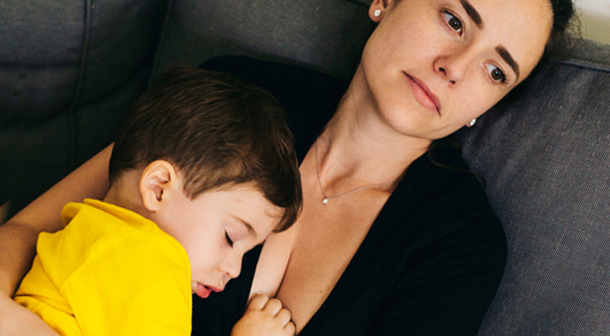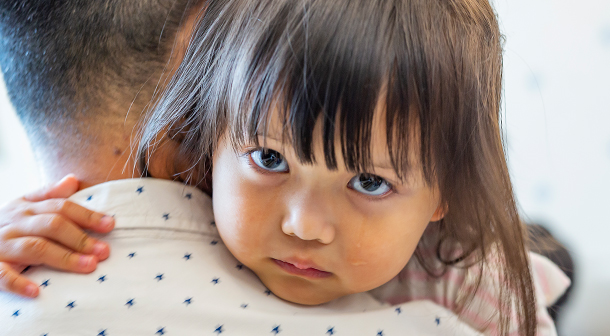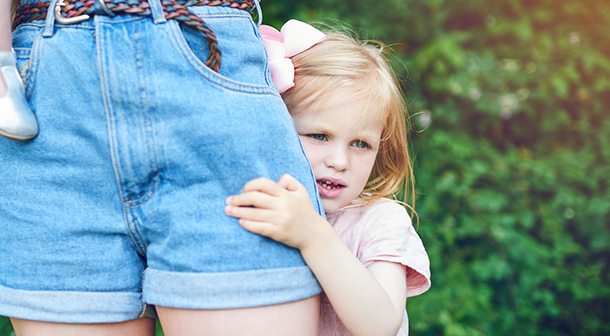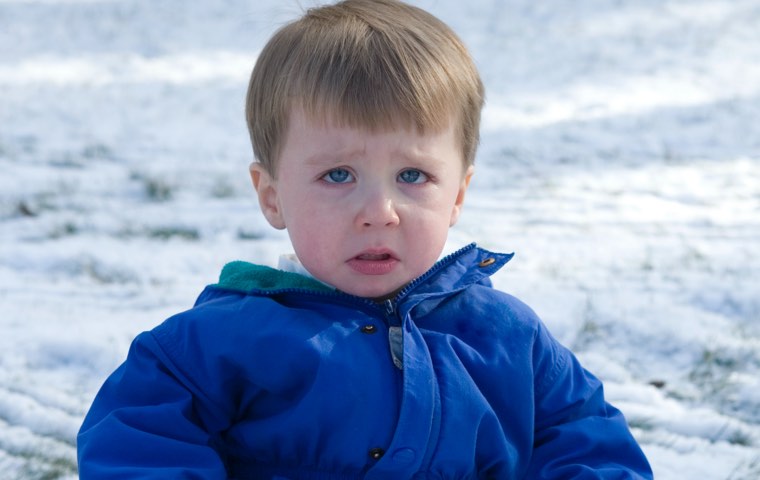5 Steps to Deal With a Clingy Toddler
By GetParentingTips.com staff
Read Time: 6 Minutes
My child wants to be held all the time.
"Why is my toddler so clingy?"
"My crying toddler wants me to pick him up, but if I do then I can't do anything else."
"My arms and back hurt from carrying my son around all the time."
"He melts down every time I leave the room."
"It took 30 minutes to drop him off at child care!"
Do these sound familiar? If so, you are not alone. If your child wants to be in physical contact all the time it can be exhausting to try to get anything done. If your child is clingy it means you've done a good job of making him (or her) feel safe with you. When things feel scary or unpredictable, your clingy child is basically telling you, "Hey, I need a little extra support here!"
Understanding Clinginess and Separation Anxiety
Clinginess is a natural reaction for children experiencing separation anxiety, or fear of being separated from a person they trust. Separation anxiety tends to be strongest from ages 9 to 18 months and usually improves by the time a child is 3. These stages correspond to phases of young child development.
Around 9 months, an infant realizes for the first time that you are actually gone when he can't see you. He may cry when you leave the room or refuse to go sleep unless you're nearby. He hasn't yet learned about what's called "object permanence" - that is, that objects still exist even when he can't see them. Even when a toddler understands this concept, he will still depend on you for help and could be frustrated if you're out of sight when he wants you. Suddenly, your independent toddler becomes a clingy child who won't let go.
The bottom line for children with separation anxiety is that they fear you will leave and not return. Some children become clingy and whiny during goodbyes, such as drop off time at child care. Others are clingy throughout the day and especially at bedtime. As a parent, your first job is to assess why your child is being clingy so you can help him through it.
Separation anxiety is not the only cause of clinginess. A child may be clingy when he is tired, hungry, or off his schedule. Physical changes, like teething or getting over an illness, can also make a child more whiny or clingy than usual. If none of these seems to be the cause of your toddler's clingy behavior, try to identify whether there's another reason he may be unsettled. Are new people around, or are you in a new place? Has there been a change in activity around the house? Could your child sense that something is going on with other family members? Changes like these can affect your child's behavior.
Need parenting help now?
The Texas Parent Helpline is available 24/7.
- Call 833-680-0611
- Chat with us
- Text 833-680-0611

A 5-Step Action Plan for Clingy Toddlers at Home
Many parents want an action plan they can follow when their toddler's clinginess gets out of hand at home. Once you know your child is not hurt, ill, or genuinely distressed, it's okay not to give in to his demands to be held or carried. You can offer support and comfort in other ways. So, what can you do?
Stop and listen.
When your child seeks your attention, bend down to his level and make eye contact. This lets him know you are listening, and it should help calm him because he has your attention. Try not to push him away - this could make him feel insecure about coming to you in the future.
Find out what's wrong and offer reassurance.
Talk to your child about why he wants to be held or carried. Young children don't have the emotional skills or vocabulary to express their feelings and needs. You can help by teaching him some words and strategies to use. "Are you too tired to finish the game? Why don't you rest with your lovey for a few minutes? I'll be right where you can see me."
Comfort.
Whiny, clingy behavior may be one way your child seeks affection. It's hard to continue providing hugs when you are exhausted by repeated requests for attention. One way to help your child feel more secure is for you to "store" hugs and kisses on his hand or a favorite stuffed animal or lovey. You can tell him, "You can get a hug or kiss right here any time you want it. I'll add some more tomorrow to make sure you never run out."
Keep talking.
Often, a child wants to be held when you are doing other activities. In these times, describe to your child what you are doing and why you can't hold him right now. You might say, "Mommy is using a sharp knife to cut the carrots, so I can't hold you now. But I'm right here! And soon we'll all have dinner together." Do your best to stay calm and speak in a soothing voice. You can also ask your child questions to try to redirect his attention and involve him in what you're doing. For example, if you are cooking, you might say, "Which do you like better, carrots or peas? I like them both!"
Be patient.
Young children learn and develop at an incredibly fast pace, but sometimes it seems they'll never outgrow clingy behavior. If clinginess has become a habit with your child be firm but patient. Give your child lots of affection and praise for good behavior - but be firm about not picking him up as a reward for whining.

Hang in there and find the right solutions that work for you and your child. Remember, this phase will pass.
How to Avoid Clingy Goodbyes
Many children who get along fine at home turn clingy when it's time to say goodbye. They may become anxious and uncooperative when parents are getting ready for work or it's time to go to child care. Clingy goodbyes tend to be loud, tearful, difficult to stop, and painful for parents and children.
Here are 5 strategies to help prepare children for transitions and make goodbyes as easy as possible.
Create a family routine.
Children do best when they are secure and know what to expect. A morning routine where you do everything in the same order helps a toddler know what's coming next. For example, "Now it's time to finish breakfast. Now we put on your shoes. Now we go to the car." Be consistent when it's time for drop-off, too. "Now I give you three kisses, and then I leave for work. I'll see you this afternoon!" Keep the drop-off routine short, sweet, and consistent. For the routine to work make sure you stay calm, use a friendly and firm tone, don't criticize or threaten punishment, and reiterate that you will be back to pick him up.
Pay attention.
When you drop off a toddler - or when you leave him with a sitter - give your full attention to the goodbye. Be loving and affectionate and always tell your child you will be back. Then say goodbye quickly and leave. His fussing will end much sooner if you do not linger.
Leave and stay gone.
Resist the temptation to turn back to see how your child is doing. Seeing you come back will make him even more anxious and make the second goodbye even harder.
Use a child's vocabulary.
Children often want to know when you'll be back, but they don't tell time like adults. Instead of saying, "I'll be back at five o'clock," tell him, "I'll be back after you eat your afternoon snack and play on the playground."
Practice being apart.
Practice makes everything easier. Schedule play dates or ask friends or family to provide child care in your home for short periods. Your toddler will gain trust and confidence as he gets used to being separated. Praise him for handling the separation and give him plenty of love and reassurance that you will always return.

Children learn through play. One way to practice goodbye routines is by role playing with stuffed animals or dolls. You and your child can take turns being the parent and trying out different ways to help him feel safe. Play is also a good way to help your child develop a better vocabulary to express his feelings and needs.
You've Got This
Parenting is hard, and when you have a clingy toddler it can be emotionally and physically tiring. But your patience will help teach your child the skills he needs to be independent. Keep up the good work and know this clingy toddler phase won't last forever!
Also, remember that you don't have to do this by yourself. If you're feeling overwhelmed, get help from your partner, family, or a friend. The Texas Youth Helpline at 1-800-989-6884 is available to help parents with younger children as well as teens.




